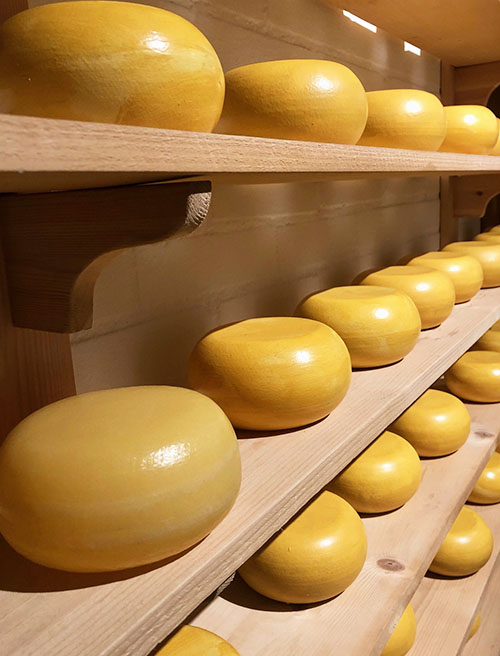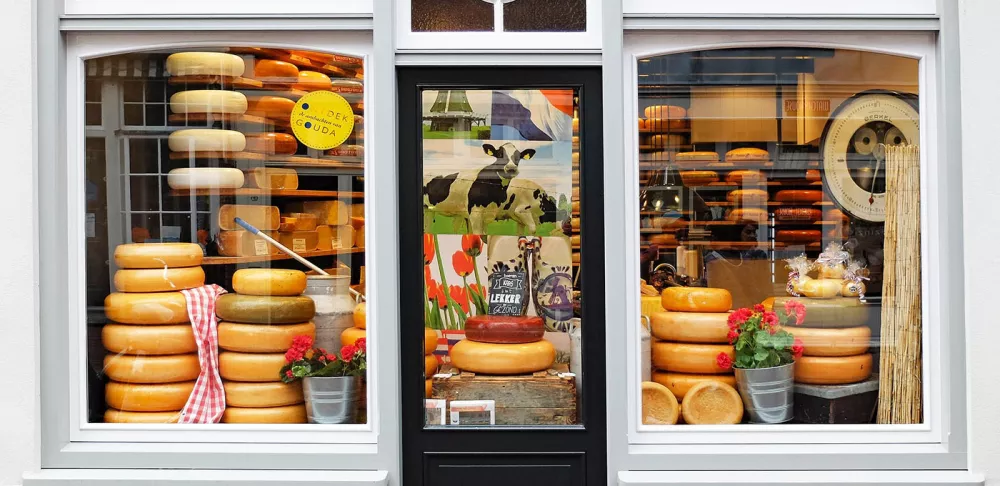Gouda, in my experience, is one of the least controversial cheeses out there: a little sweet, a little nutty, sometimes smoked, but always welcome, whether in a cheese plate, sandwich or composed dish.
Lots of different cheese styles — even popular ones — have their detractors, but whenever I teach cheese classes, I’ve never met someone who doesn’t say they absolutely love gouda. It inspires enthusiasm, more than any other cheese style I know.
For being one of the best loved cheeses, however, I couldn’t find a single source that lists it among America’s most popular cheese styles.
This, I believe, is because we don’t really know what gouda is, other than likable. It doesn’t immediately come to mind when pressed for a favorite cheese, because it doesn’t have a place in an iconic cheesy dish (though it works in so many), and other than its (sometimes) red wax exterior, it doesn’t have any salient features that make it particularly memorable when stacked up against the cheddars, bries and blues of the world.
So let’s get to know this crowd-friendly sweetheart, with four things you should know about gouda.
1. Gouda Is a Place
Gouda (pronounced “HOW-duh” in Dutch), is named for a place and can trace its origin back to the 13th century, making it one of the oldest cheeses still in production. Like other place-named cheeses such as cheddar or brie, “gouda” has become a generic term over time referring to its style, and is therefore often uncapitalized.
Related Reading: Understanding Cheddar
Gouda originates in the Netherlands town of the same name, but unlike a lot of place-named cheeses, the city of Gouda isn’t necessarily where the cheese was made, but rather where it was sold, with farmers from all over the country bringing their cheese to Gouda to be marketed or shipped during a time when the Dutch government allowed for this kind of monopoly. Like cheddar, the term gouda has never had a PDO — “Protected Designation of Origin” — status, meaning that it can be made anywhere, from any kind or condition of milk, with various types of rinds and inclusions, all over the world.

2. Gouda’s Unique Technique
This doesn’t mean that goudas don’t have specific characteristics that define them, however.
Goudas do tend to have a couple of important things in common, despite the wide range of variables available when it comes to making it. The two things that give gouda its particular character, no matter where it is made, are its shape, which is a flattened wheel, and its particular make technique. All cheese is made by coagulating milk, and then pressing the resulting curds into molds. How the curds are treated: salted, cut, stacked, shaped, pressed or heated, all give rise to differing textures or flavors in cheese.
In the case of gouda, the curds are washed. (Which is not to be confused with washed rinds, which results in a very different type of cheese.) Rinsing the curds before they go into molds washes off some of the lactose, which means there is less lactose available to convert to lactic acid while the cheese ages. Without the sharpness or tang from lactic acid, goudas then tend to have very sweet flavors: a fruitiness in young goudas, becoming more nutty in older expressions, to tasting like butterscotch candy in the oldest varieties.
3. The Formation of Cheese Crystals
Crystals will form in aged cheeses of many varieties, but because aged goudas are so ubiquitous (and so addictive), that crystalline crunch is often associated with the type. Those cheese crystals aren’t a concentration of salt, nor sugar, despite giving the effect of cheese candy. The crystals that can be found in gouda are called tyrosine crystals, which form due to the breakdown of protein in the cheese as it ages, and are actually clusters of amino acids.
Speaking of being addictive, tyrosine is associated with the production of dopamine in the body, so if you feel like eating cheese always puts you in a good mood, that’s not only because it’s delicious. (There’s science to back that.)
4. Wax On, Wax Off
Gouda is often associated with having a thick, red wax exterior. While this is not the case with all goudas, many wheels of gouda are dipped in at least a thin coating of wax or some other kind of seal. The wax is technically edible, though it hardly qualifies as delectable, but it definitely also contributes to gouda’s craveability.
Cheeses that are aged in an anaerobic environment — such as those vacuum sealed in plastic, or dipped in wax as with gouda — go through a different kind of microbial transformation than cheeses that are exposed to the air during aging. This helps preserve moisture in the cheese, which results in cheeses that still retain some of their creamy texture, even with several years of age.
Related Reading: Understanding Cheese Rinds
A Few Goudas to Know
Ewephoria: Ewephoria is a sheep’s milk gouda, devised by a Seattle-based importer in partnership with a Dutch creamery, in order to create a particularly sweet and nutty, rich aged gouda that would especially appeal to American palates.
The Farm at Doe Run 7 Sisters: A cow’s milk gouda made in Pennsylvania, this is a relatively young gouda, with only about eight months of age, but that still has plenty of nutty flavors. The high quality milk used for this cheese also expresses itself as notes of wildflowers and herbs.
Cypress Grove Midnight Moon: Midnight Moon was the particular cheese that snagged me and started my artisanal cheese journey. As a goat’s milk gouda, there is a noticeable tang to the cheese, giving the effect of salted caramel to its flavor.
More Fundamentals of Cheese:






